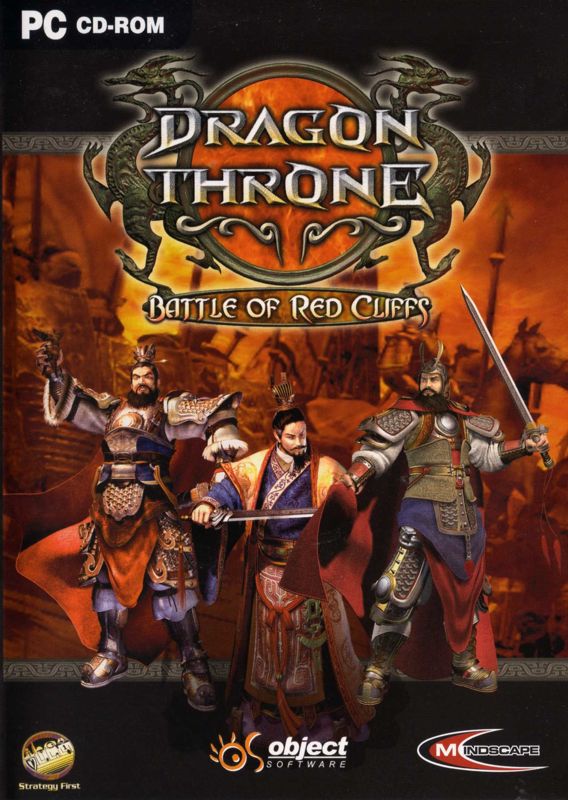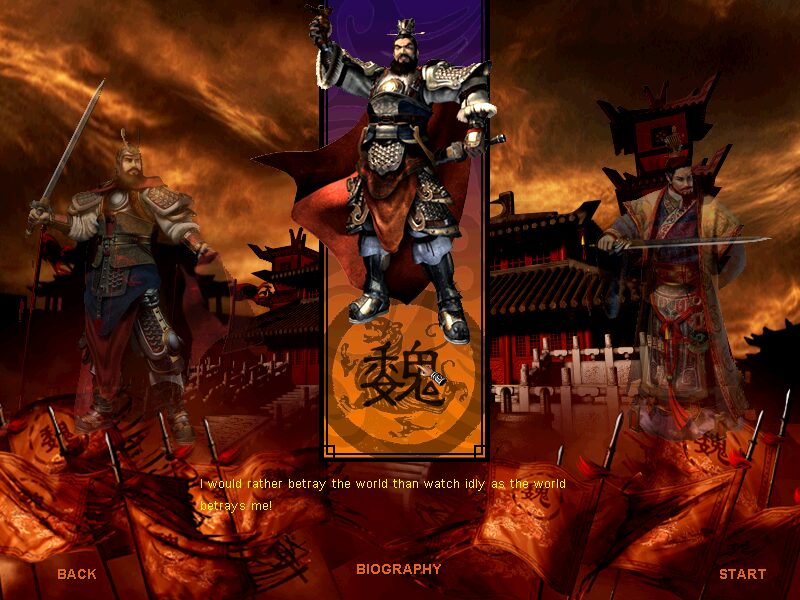Retro Replay Review
Gameplay
Dragon Throne: Battle of Red Cliffs embraces the classic real-time strategy template popularized by titles like the Age of Empires series, yet it weaves in its own distinctive elements drawn from the Three Kingdoms saga. You’ll manage six vital resources—rice, wood, stone, iron, gold, and horses—each critical to building armies, fortifications, and economic structures. From the first settlement to sprawling fortresses on the Yangtze’s banks, resource gathering remains intuitive, though later stages demand careful balancing to fuel continuous unit production and hero upgrades.
(HEY YOU!! We hope you enjoy! We try not to run ads. So basically, this is a very expensive hobby running this site. Please consider joining us for updates, forums, and more. Network w/ us to make some cash or friends while retro gaming, and you can win some free retro games for posting. Okay, carry on 👍)
One of the game’s standout mechanics is its unit experience system. Every infantryman, archer, and cavalry unit accrues battlefield experience, gradually improving combat performance. Hero units take this further with skill trees that let you customize their strengths, whether bolstering offense, defense, or support capabilities. Combat becomes a chess match of positioning seasoned troops alongside novice recruits, all while capitalizing on hero abilities to tip the balance in crucial skirmishes.
Diplomacy and trade inject another strategic layer. You can forge short-term alliances with rival warlords, negotiate resource swaps, or even manipulate AI factions through tribute. Managing these suzerainty relationships adds depth beyond brute force; a well-timed alliance with Sun Quan can stymie Cao Cao’s southward expansion, for example. Meanwhile, the multiple map system ensures that each multiplayer match or skirmish feels fresh, from river estuaries to rugged highlands.
Multiplayer support shines with 2–8 player LAN and 2–4 player internet matches, allowing friends or online opponents to reenact historic encounters or create new ones. Matchmaking can be sparse compared to modern RTS titles, but the robust LAN options and built-in spectator views compensate for modest online traffic. Overall, Dragon Throne balances its medieval-era physics with modern conveniences, making the gameplay both accessible to newcomers and sufficiently deep for RTS veterans.
Graphics
The game’s isometric 2-D perspective captures the look and feel of ancient China with a surprising level of detail. City walls, watchtowers, and troop banners carry authentic color palettes, and terrain tiles—from misty riverbanks to terraced rice paddies—are meticulously rendered. While the sprites and environment may feel dated next to contemporary 3-D engines, the art direction remains charming and historically evocative.
Unit animations are fluid for their time, with marching formations, archers drawing bows, and cavalry charges all clearly distinguishable on the battlefield. Hero models are slightly larger than standard units, making it easy to track your champions as they unleash powerful skills. Subtitled Mandarin voice acting enhances immersion; hearing generals bark orders in their native tongue adds gravitas, even if the voiceovers occasionally loop during prolonged engagements.
Static elements, such as UI panels and minimaps, adhere to a clean, functional design. They provide quick access to build queues, resource tallies, and diplomacy menus without overcrowding the screen. The downside lies in limited zoom levels and absence of landscape shading effects found in newer RTS games. Yet, these omissions rarely hamper strategic oversight, as the view remains clear and responsive even during intense clashes.
Environmental effects—like flickering torchlight in nighttime scenarios or seasonal foliage changes—add subtle visual variety. Weather is purely cosmetic and doesn’t influence gameplay, but occasional rain or fog screens create atmospheric tension before pivotal battles. Overall, Dragon Throne’s graphics may not break technological frontiers today, but their historical authenticity and straightforward clarity serve the player well.
Story
Spanning a 15-year stretch around the legendary Battle of Red Cliffs in 208 AD, the single-player campaign immerses you in the power struggle among Cao Cao, Liu Bei, and Sun Quan. Each faction’s narrative branch unfolds from distinct vantage points: Cao Cao’s imperial ambition, Liu Bei’s righteous quest for legitimacy, and Sun Quan’s coastal defense strategies. This tripartite structure offers varied objectives, from siege warfare to naval blockades, ensuring the story never feels repetitive.
The writing strikes a balance between historical events and dramatic embellishment. Briefing screens present period-accurate context and decision-making dilemmas, such as whether to press forward against an enemy flank or consolidate supply lines. In-game cutscenes, though rendered with in-engine graphics, capture pivotal moments—like Zhuge Liang’s famed fire attack—heightening the sense of epic scale. Subtitles keep dialogue crisp, letting non-Mandarin speakers follow complex political intrigues with ease.
While the campaign hews closely to recorded history, it allows for alternative outcomes based on your performance. A failed defense at Xiakou can pivot Sun Quan’s storyline toward guerrilla tactics, while an early defeat in northern China shifts Cao Cao into desperate resource raids. These branching paths encourage replayability, inviting players to explore “what-if” scenarios within the Three Kingdoms mythos.
The characters themselves—hero generals, loyal lieutenants, and formidable enemies—are well fleshed out. Their personalities emerge through battle banter and mission briefings, making you care about their fates. Even side characters receive moments in the spotlight, such as Zhou Yu’s strategic counsel or Guan Yu’s solemn vow, adding layers to an already rich tapestry of alliances and rivalries.
Overall Experience
Dragon Throne: Battle of Red Cliffs stands as a robust RTS title that caters to both single-player enthusiasts and multiplayer tacticians. The learning curve is moderate: basic resource collection and unit commands are intuitive, but mastering diplomacy, unit XP distribution, and hero skill trees demands patience. Fortunately, the comprehensive tutorial campaigns guide new players through each system before thrusting them into high-stakes battles.
Multiplayer sessions, though reliant on LAN or handfuls of online rivals, are among the game’s highlights. Matches can turn into marathon affairs as alliances shift and resource nodes deplete, rewarding strategic foresight and adaptability. If you can rally a dedicated group of friends, Dragon Throne’s skirmish modes can sustain months of competitive fun. The spectator mode also makes it ideal for hosting small tournaments or viewing replays of epic confrontations.
On the flip side, some users may find the interface a touch clunky by modern RTS standards, particularly when juggling multiple hero abilities or issuing rapid formation changes. Occasional AI pathfinding quirks surface, such as siege engines getting stuck on uneven terrain. Yet these technical hiccups are relatively minor against the backdrop of a compelling strategic experience.
In sum, Dragon Throne: Battle of Red Cliffs delivers an engaging blend of historical authenticity and proven RTS gameplay. Its blend of six-resource management, dynamic unit progression, and diplomatic maneuvers ensures that each campaign and multiplayer match feels both challenging and rewarding. For fans of Three Kingdoms lore or real-time strategy veterans seeking a different cultural setting, this title remains a compelling choice.
 Retro Replay Retro Replay gaming reviews, news, emulation, geek stuff and more!
Retro Replay Retro Replay gaming reviews, news, emulation, geek stuff and more!









Reviews
There are no reviews yet.